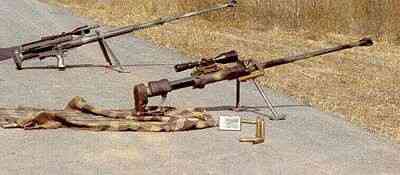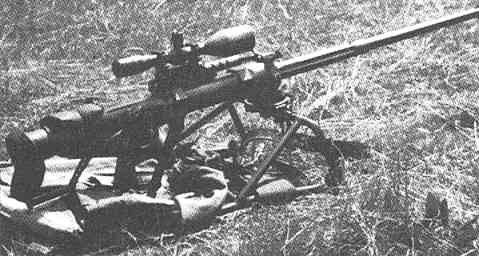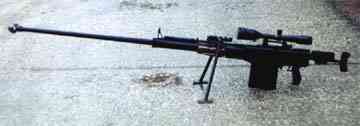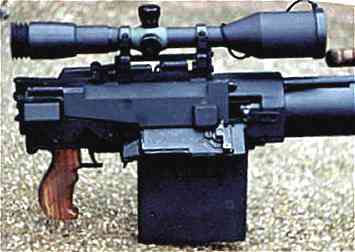
 |
Hungarian Gepard Sniper Rifles |
 Origin of the Gepard Rifles
Origin of the Gepard Rifles
Design considerations were:
1. The 12.7x107mm cartridges muzzle energy is about 5 times more than the 7.62mm's. The shooter cannot handle this without a muzzle compensator.
2. To efficiently use the cartridge's energy, the barrel needs to be at least 1100mm long. (Muzzle velocity 850m/s). A conventional buttstock would
increase the length to 1600mm [63"], too long for efficient battle handling. The rifle needs to be redesigned in 'bull-pup' style and/or collapsible stock
or carried disassembled with quick field assembly possibility.
3. The rifle is too heavy to use without a bipod or tripod.
4. During firing while the bullet travels in the barrel the rifle moves backwards about 6-8mm. If this movement not purely axial, the accuracy will suffer.
The rifle's muzzle end has a tendency to jump up when the bullet leaves the barrel. If the muzzle jumps within the gas-reaction-zone, (200mm in front of
the barrel for this caliber), the accuracy will suffer.
Overall the rifle's recoil must not be larger than the Dragunov SVD Sniper's, the accuracy and effective distance must be significantly better than the
SVD's, the rifle length must be less than 1500mm [59"] and lighter than 16kg. Two different design is necessary, one for the single shot version, the other
for the semi-automatic rifle.
The following energy-amortization was considered in the design: The barrel is allowed to slide axially back 100mm against a spring force. This increases
accuracy over fixed barrels and decreases gun recoil. A spring-loaded buttstock located in-line with the barrel also decreses the recoil. A muzzle
break can be designed and installed to compesate for the remaining recoil.
 June 1988: the first version has a 100x100m crossection welded/machined steel receiver, muzzle break, a top loading 5-round magazine, two 40mm amortisator,
weighing 22 kg [48 lbs]. Muzzle Velocity 850m/s. It appeared bulky, heavy and not pretty.
June 1988: the first version has a 100x100m crossection welded/machined steel receiver, muzzle break, a top loading 5-round magazine, two 40mm amortisator,
weighing 22 kg [48 lbs]. Muzzle Velocity 850m/s. It appeared bulky, heavy and not pretty.
A simplified, reworked single-shot version called Gepard-1, shown on the left, was made by István Fellegi of FETE (now his own company) in Nov. 1988.
It was mounted on a PKM stand.
 In December 1988 Fellegi made the semiauto version called Gepard-2, shown on the left. It had a 5-round removable box magazine attached to the left side of
the receiver. The receiver was 80x100mm cross-section light alloy. The rifle weight was 22kg [48 lbs]. It had a PKMSZ stand and its own bipod. During
testing at 150m, it shot smaller than 20mm [3/4"] groups. Two consecutive shots penetrated a 60mm steel plate. A 7x scope was attached.
In December 1988 Fellegi made the semiauto version called Gepard-2, shown on the left. It had a 5-round removable box magazine attached to the left side of
the receiver. The receiver was 80x100mm cross-section light alloy. The rifle weight was 22kg [48 lbs]. It had a PKMSZ stand and its own bipod. During
testing at 150m, it shot smaller than 20mm [3/4"] groups. Two consecutive shots penetrated a 60mm steel plate. A 7x scope was attached.
 In February 1989 Gepard-3, a single shot sniper rifle was completed. It was equipped with a 4-12x Japanese Nikko-Stirling Butterfly scope. It had no rear
and front sights. It had a PKMSZ stand and its own bipod. The bipod is angled 7 degrees to the front and 30 degrees apart. The rifle is mounted hanged from
the bipod.
In February 1989 Gepard-3, a single shot sniper rifle was completed. It was equipped with a 4-12x Japanese Nikko-Stirling Butterfly scope. It had no rear
and front sights. It had a PKMSZ stand and its own bipod. The bipod is angled 7 degrees to the front and 30 degrees apart. The rifle is mounted hanged from
the bipod. In February 1990 the Gepard-3 single shot sniper rifle was updated. The scope mount and bipod from the M1 was used, and a rear support was added close to
the butt. During 1990 the Hungarian Military become interested again and run several trials, also a few Europeans shown commercial interests.
In February 1990 the Gepard-3 single shot sniper rifle was updated. The scope mount and bipod from the M1 was used, and a rear support was added close to
the butt. During 1990 the Hungarian Military become interested again and run several trials, also a few Europeans shown commercial interests.
 For simplicity the grip is acting as the locking mechanism. Loading is done while the grip rotated in 90deg. When the grip is rotated back to its normal
position, a 2-prong head is locked. The grip also contains the firing mechanism. The grip is rotated manually to the right to eject the empty shell after
firing. The rifle is equipped with a safety.
For simplicity the grip is acting as the locking mechanism. Loading is done while the grip rotated in 90deg. When the grip is rotated back to its normal
position, a 2-prong head is locked. The grip also contains the firing mechanism. The grip is rotated manually to the right to eject the empty shell after
firing. The rifle is equipped with a safety.
 Caliber: 12.7x107mm B32 or MDZ23, 12.7x99mm NATO (.50 Browning), single shot
Caliber: 12.7x107mm B32 or MDZ23, 12.7x99mm NATO (.50 Browning), single shotIn February 1990 the Gepard M1 Sniper Rifle was completed. Improvements were made to its receiver, scope, muzzle break and bipod. It also had an attachable flex-joint rear support. Loading/unloading is done the same way as the Gepard-3, with the 90 degree rotation of the grip. The grip does not need to be removed for this purpose (as some may claim).
May 1992 issue of Guns Review tested an M1 showing impressive 10" groups at 1280 meters [1400 yards].
 In February 1990 the variant of the M1, Gepard M1A1 Sniper Rifle was also introduced. In comparation to the M1, the M1A1 has a lighter barrel, a 2-stage
muzzle brake. The receiver is made from a light weight alloy.
In February 1990 the variant of the M1, Gepard M1A1 Sniper Rifle was also introduced. In comparation to the M1, the M1A1 has a lighter barrel, a 2-stage
muzzle brake. The receiver is made from a light weight alloy.
In July 1991 18 Gepards were shipped to the Army and RKSZ (anti-terrorist unit). During military testing 3 M1A1's destroyed a helicopter size target at 1800
meters. In October 1991 a Hungarian designed, improved and manufactured scope with internal adjustments replaced the Japanese Nikko scopes. During testing
the new scopes, sharpshooters hit man-size targets at 1200 meters. In November 1991 the Army officially adopted the Gepard M1A1 Sniper Rifles. The Gepard
received several patents.
The rifle can be quickly disassembled for carrying, with the longest piece 1200mm, fitting into a carrying backpack. The carrying bag frame also serves
as the rifle stand. Complete weight with accessories 21kg.
 Caliber: 12.7x107mm B32 or MDZ23, 12.7x99mm NATO (.50 BMG), 10-rd magazine
Caliber: 12.7x107mm B32 or MDZ23, 12.7x99mm NATO (.50 BMG), 10-rd magazine
Length 1410mm, Weight 16kg
Barrel length 1100mm, Muzzle Velocity 833m/s
In December 1989 a semiautomatic Gepard M2 pictured on the left was completed. It has a 10-round, double row removable box magazine, attached to the bottom
of the light alloy round receiver behind the grip. It had a PKMSZ stand and its own bipod. It was equipped with a 4-12x Japanese Nikko-Stirling Butterfly
scope, but also had the mechanical sights. The barrel had a muzzle brake.
During firing the barrel and bolt travels backwards together. During the 68mm travel the barrel is disengaged from the bolt and stopped by a flexible
bumper. The coil spring located around the barrel moves it back to its normal position. At the same time the bolt keeps moving backwards by its momentum,
extracting the shell from the chamber. The shell is ejected by a fixed ejector, and the bolt is stopped by a flexible bumper. The bolt spring returns the
bolt to its normal position, picking up a new cartridge on the way and locks into the barrel at its firing position. The rifle is capable to achieve a 20
rounds per minute firing rate. Trigger pull is 15-20N.
 In October 1991 a Hungarian designed, improved and manufactured scope with internal adjustments replaced the Japanese Nikko scopes. The Hungarian scope can
also withstand the shaking associated with the powerful 12.7mm rounds, while the Nikko did not fare well. The scope mounts accept any 25.4mm [1"] scope.
Night vision can be fitted to the new scopes.
In October 1991 a Hungarian designed, improved and manufactured scope with internal adjustments replaced the Japanese Nikko scopes. The Hungarian scope can
also withstand the shaking associated with the powerful 12.7mm rounds, while the Nikko did not fare well. The scope mounts accept any 25.4mm [1"] scope.
Night vision can be fitted to the new scopes.
Barrel swap to a different caliber (from the Russian 12.7mm to the Browning .50 cal) takes 2-3 minutes, no other alteration is necessary. The Russian
cartridge is 8mm longer and 16-18% more powerful, but for export purposes the .50 NATO is more marketable.
 This is believed to be the shortened barrel version of the M2 rifle designated M2A1. Based on the picture its relationship to the M2 is questionable.
The action with its grip and trigger assembly located off-center, at the right side of the magazine appears to be a derivative of the Gepard M3 described
below.
This is believed to be the shortened barrel version of the M2 rifle designated M2A1. Based on the picture its relationship to the M2 is questionable.
The action with its grip and trigger assembly located off-center, at the right side of the magazine appears to be a derivative of the Gepard M3 described
below.
 In December 1991 the 14.5x114mm Russian caliber semiauto Gepard M3 shown on the left was completed. It has a 5-round magazine attached to the bottom of the
receiver. The trigger and grip are located at the right side of the magazine. It has a Hungarian scope and no sights. Muzzle Velocity 976m/s. This cartridge
increased the accuracy and effective range of the rifle. Weight 21kg
In December 1991 the 14.5x114mm Russian caliber semiauto Gepard M3 shown on the left was completed. It has a 5-round magazine attached to the bottom of the
receiver. The trigger and grip are located at the right side of the magazine. It has a Hungarian scope and no sights. Muzzle Velocity 976m/s. This cartridge
increased the accuracy and effective range of the rifle. Weight 21kg
 Caliber: 12.7x107mm Russian or 12.7x99mm NATO (.50 BMG)
Caliber: 12.7x107mm Russian or 12.7x99mm NATO (.50 BMG)
 Caliber: 12.7x107mm Russian or 12.7x99mm NATO (.50 BMG)
Caliber: 12.7x107mm Russian or 12.7x99mm NATO (.50 BMG)
 Weight with mag: 11.5kg [26 lbs]
Weight with mag: 11.5kg [26 lbs]